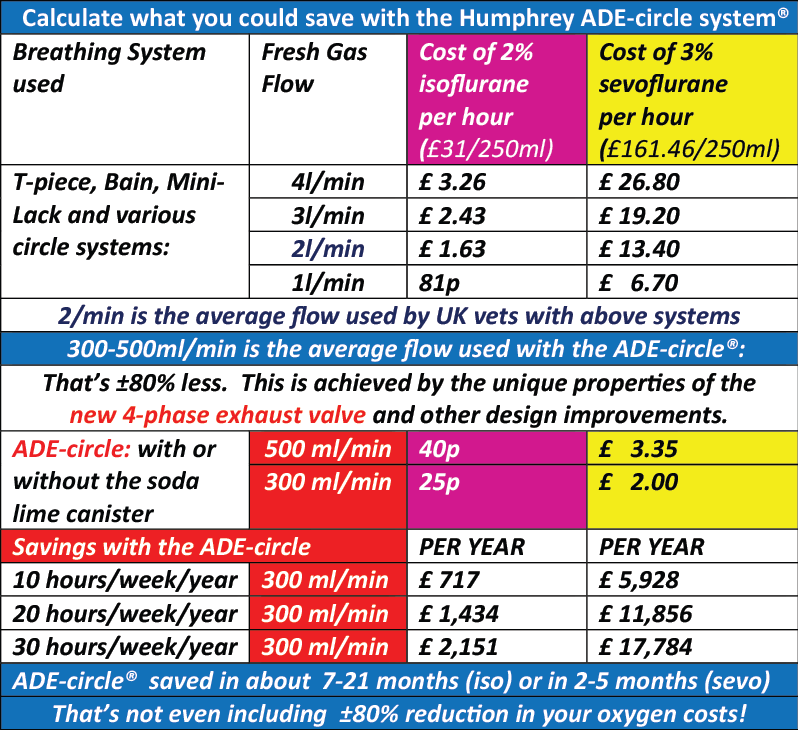Sevoflurane – is it really advantageous over Isoflurane?
Written by Dr David Humphrey, MBBS, DA:
Medical anaesthetist and Designer of the Humphrey ADE-circle system.
Note: The author has conducted many clinical trials comparing sevoflurane with isoflurane when using the Humphrey ADE-circle system; this report summarizes his observations using capnographs and agent monitoring.
Induction: Sevoflurane generally has better anaesthetic properties and physical characteristics than isoflurane. Anaesthetic vapour is absorbed across the respiratory alveolar membrane into blood and is circulated to the brain and all tissues from where it is absorbed. As sevoflurane is less soluble in tissues (especially fat) than isoflurane, less is absorbed and more stays in blood and goes to the brain. This results in a faster induction (usually complete within 2-3 minutes). Normal vapour percent for sevoflurane is around 3% but varies widely between patients, while for isoflurane it is around 2%; although isoflurane is a stronger anaesthetic agent, more is absorbed into the tissues, making induction longer (especially in fat patients). Sevoflurane has a sweet less pungent smell and, unlike isoflurane, is much more accepted by animals making a mask induction less traumatic and quicker. Analgesic drugs are synergistic and, if given with the premedication, both sevoflurane and isoflurane can often be reduced by 1% or more.
Maintenance: As very little sevoflurane is absorbed from blood after induction, blood concentration remains very stable. If the vaporizer setting is altered, blood levels change quickly, giving rapid control over the depth of anaesthesia. With isoflurane, changes in blood concentration is much slower as isoflurane has to re-stabilize in the tissues.
End of Anaesthesia: At the end of an anaesthetic there is little sevoflurane in the tissues so that what is left in blood is quickly eliminated; recovery times are quicker than isoflurane because all isoflurane absorbed into tissues now reverses back into blood, keeping brain concentration up before being eliminated. This is especially true in fat patients.
Recycling through soda lime: Here sevoflurane has a great advantage over isoflurane. Because sevoflurane is almost insoluble in tissues, it just circulates in blood. When blood returns to the lungs, sevoflurane transfers back to the alveoli to be expelled in expired gas. If this gas is recycled, it is returned to the patient and maintains the anaesthetic depth at an almost constant depth. Sevoflurane therefore provides a very stable anaesthetic even at exceptionally low fresh gas flows. With isoflurane and because it is continuously being absorbed by tissues, the result is that the concentration in blood falls. The isoflurane removed from blood must be replaced and is only achieved by turning up the vaporizer by 1% (from around 2% to 3%). If this is not understood by non-specialist staff, the patient (especially if fat) will become light and react to pain.
Cost: Sevoflurane is more expensive per 250ml bottle. Luckily, in South Africa, a generic vapour only costs 35% more, but if used with the low flows of just 300 ml/min with the Humphrey ADE-circle system, the cost is R17 per hour compared with R 8.21 using isoflurane (see chart below). This difference (just R8.79/hr) is insignificant when compared to the benefits of sevoflurane over isoflurane.
Conclusion: Sevoflurane is an advance on isoflurane, and in medical practice has replaced isoflurane. On first using it, staff must be aware that it is quick-acting and that anaesthesia is normally achieved in 2-3 minutes and much faster than isoflurane. On induction, monitoring the clinical signs of the depth of anaesthesia is important, but once stable little adjustment is required. As recovery with sevoflurane is also much quicker, post-op analgesia must be given sooner or even with the premedication. The Humphrey ADE-circle system has been a game-changer when using sevoflurane, as the system uses such low fresh gas flows as to make it very affordable. Those vet staff who use sevoflurane love it.

